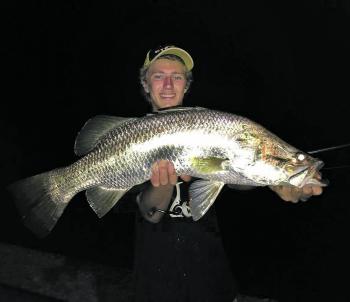A surface strike of a feeding fish is something that always seems to amaze us, whether it’s a bumper bass sipping an insect in the glare of the morning sun or a monster giant trevally exploding into a school of bonito on sunset. This is truly when we get to see the pure power and grace of how predatory fish feed.
The tropical waters up here in the Cape are loaded with a huge variety of species that will actively take surface lures. The high water temperatures and lack of commercial pressure result in the fish stocks often feeding violently on the surface.
The pelagic species are known for their tendency to destroy surface presentations, however, there is still a lot to understand about fishing for pelagics on surface. On days when species such as tuna and queenies are very fixated on small baitfish (baitfish under 3”) they can be very difficult to attract on big poppers and stickbaits. Generally slugs, jigs and small soft plastics are the go. To improve the actual physical element of a surface strike, use light to unweighted plastics so the presentation is just under the surface by about an inch. This is just as impressive to watch as a fish taking a stickbait.
This is often what southern fishers have to do when fish are eating small bait, but this is Cape York. Many times, even when the pelagics are feeding on bait as small as 1cm, they still chase down big poppers and smash them without hesitation. Often it takes a few casts to get tuna interested at all. Queenies will chase the lure right to the boat and then, to the agony of so many anglers, turn away and return to the bait school.
Persistence does eventually pay off, though. If you get enough casts into a feeding frenzy, you’ll hook up. Sometimes it’s not one of the dozens of ignorant tuna and queenfish that will strike your lure around a bait school, but instead a lone monster lurking below, such as a 50lb mackerel or big toothy barracuda.
Small to medium sized brassy and giant trevally often cruise alongside other pelagics and are often more aggressive towards surface presentations than other species on tough days. Then there is the holy grail of every angler chasing some line burning action: when a massive cobia comes out from amongst the other fish to hunt down a lure – truly awesome stuff.
Surface fishing is not limited to offshore. While most fish in estuaries are smaller, they can be just as much fun. Queenfish seen in river mouths are of a similar size to the offshore fish (well over 1m) and are accompanied by juveniles. These fish make for some awesome surface explosions around headlands.
The elusive barramundi can be caught on small poppers and walk-the-dog stickbaits flicked to the snags, but the key to barra is to move the lure as slow as possible and count up to ten seconds between twitches or bloops. During hours of darkness, barra will become much more active. If they’re feeding on smaller bait, the unweighted soft plastic technique can be just as good as a popper or stickbait.
Flyfishing can also be practiced with surface patterns such as Crease flies and Dalburgs being used to catch everything from trevally and barra to even freshwater species such as sooties and toga. Good luck and remember to think like a fish.
Reads: 2936
This keen eyed barracuda around 15kg followed the author’s stickbait all the way to the boat and then smashed it, followed by screaming runs.

Night time barramundi on surface are awesome.

The author and his mate Andrew with some awesome queenies on surface lures.




